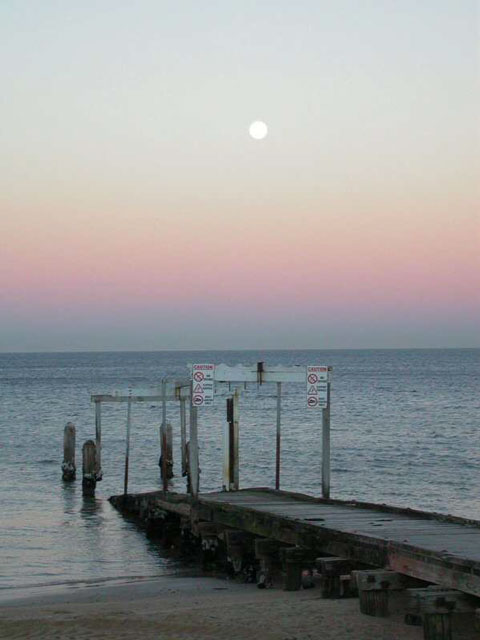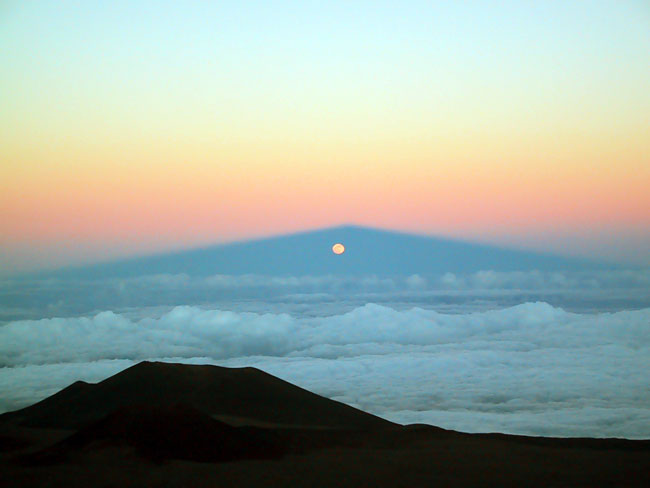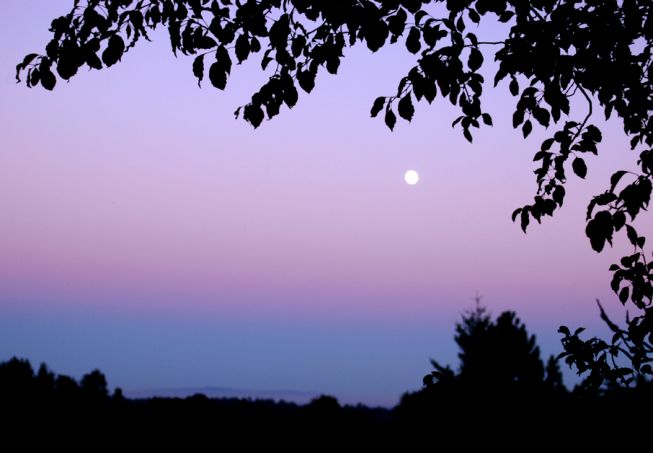Page 1 of 1
Saguaro Moon (APOD 26 Sep 2007)
Posted: Wed Sep 26, 2007 2:53 pm
by orin stepanek
http://antwrp.gsfc.nasa.gov/apod/ap070926.html
Looks so close; you feel you can almost touch it. Luna can really be intriguing at times. Even makes the wolves howl!

Orin
Posted: Wed Sep 26, 2007 5:22 pm
by iamlucky13
It's rather unreal looking. Notice the sky is hazy, yet the moon, although discolored looking, seems unobstructed, making it appear in front of the sky, even though I know it's over a hundred thousand miles behind. It's the kind of picture that begs the question of whether it's original or if it's been shopped a little bit.
Posted: Wed Sep 26, 2007 7:16 pm
by geckzilla
Might be shopped for color and contrast levels (I do see a sharpening filter for sure) but I imagine the photo itself is quite real. The sky isn't really hazy, those clouds are just really diffuse. You can see the light bending all around the moon which pretty clearly which indicates it was definitely shot through the atmosphere rather than pasted in. That, and it's totally possible. Telephoto lenses distort perspective a lot. It is something like extreme foreshortening?
Posted: Wed Sep 26, 2007 8:11 pm
by orin stepanek
It does look like it is sitting in front of the clouds; but that may be due to the fact that the moon is so bright and the clouds are very wispy and the moon literally overwhelms them; making the clouds transparent.
Orin
Saguaro Moon
Posted: Thu Sep 27, 2007 2:55 am
by StACase
Is that photo for real?
It looks like alot of sandwiched photos I've seen of a full moon in the western sky at sunset.
Posted: Thu Sep 27, 2007 3:50 am
by geckzilla
Posted: Thu Sep 27, 2007 5:49 pm
by iamlucky13
That's what I was trying to decide. On a nice, regularly-shaped object like the moon, it's not hard to fiddle with the contrast and stuff on just that area of the picture, possibly making the haze disappear that way. Or it's possible that the moon is just bright enough to wash out any of the haze that would otherwise appear across the disc.
I definitely don't think the moon was merely pasted in, but it's remarkable how it stands out against the sky. And I've never seen that color of sky around a rising moon.
The photographer must've had a huge lens for the photo...at least 400mm, probably around 600mm.
Posted: Thu Sep 27, 2007 6:08 pm
by geckzilla
I imagine that it is orange for the same reason the sun turns orange when its light shines through the atmosphere near the horizon.
Posted: Fri Sep 28, 2007 1:42 pm
by orin stepanek
iamlucky13 wrote:That's what I was trying to decide. On a nice, regularly-shaped object like the moon, it's not hard to fiddle with the contrast and stuff on just that area of the picture, possibly making the haze disappear that way. Or it's possible that the moon is just bright enough to wash out any of the haze that would otherwise appear across the disc.
I definitely don't think the moon was merely pasted in, but it's remarkable how it stands out against the sky. And I've never seen that color of sky around a rising moon.
The photographer must've had a huge lens for the photo...at least 400mm, probably around 600mm.
I think the Moon glow brightens what are very thin clouds making them seem moor prominent; yet they don't have enough substance to show up on the face of Luna.
Stefan Seip has en interesting web site which features several pictures of the Moon and other astronomical pictures.
http://www.photomeeting.de/astromeeting/_index.htm
Orin
Posted: Tue Oct 02, 2007 1:50 am
by StACase
Sorry I never looked to see if the question had been posted already.
Posted: Tue Oct 02, 2007 1:55 am
by StACase
geckzilla wrote:I imagine that it is orange for the same reason the sun turns orange when its light shines through the atmosphere near the horizon.
I think the sky in that photo is orange from the setting sun in the western sky, which means that the sun is in front of the camera, so what's shinning on the moon to make it full?
Questions questions questions questions!
Posted: Tue Oct 02, 2007 1:59 am
by StACase
Here's a similar but much more believable photo:

Posted: Tue Oct 02, 2007 10:37 am
by geckzilla
StACase wrote:geckzilla wrote:I imagine that it is orange for the same reason the sun turns orange when its light shines through the atmosphere near the horizon.
I think the sky in that photo is orange from the setting sun in the western sky, which means that the sun is in front of the camera, so what's shinning on the moon to make it full?
Questions questions questions questions!
I don't get what you are trying to say... Are you trying to say the photographer took a photo of the sun and then photoshopped the sun into the moon instead? What's the bloody point? You should just email the guy instead of asking us here, since he would know the exact circumstances and as the photographer could explain to you how he did it. If he can't explain it, then maybe you are onto something. Otherwise, oooooooh, photography conspiracy! Can't a damn thing here be not a conspiracy?
Posted: Tue Oct 02, 2007 3:54 pm
by Chris Peterson
StACase wrote:I think the sky in that photo is orange from the setting sun in the western sky, which means that the sun is in front of the camera, so what's shinning on the moon to make it full?
When you are facing a full Moon, the Sun is behind you. If you think that a sunset (or sunrise) can't make the opposite horizon red as well, you haven't seen many!
Posted: Wed Oct 03, 2007 6:27 pm
by iamlucky13
I went back to look at this picture today and another thought came to me. From the caption:
...is popularly called the Harvest Moon. According to lore the name is a fitting one because farmers could work late into the night at the end of the growing season harvesting crops by moonlight.
It's not mere lore. I've definitely been out working in the fields late at night by the light of a full moon.
Posted: Fri Oct 05, 2007 1:40 am
by StACase
Chris Peterson wrote:StACase wrote:I think the sky in that photo is orange from the setting sun in the western sky, which means that the sun is in front of the camera, so what's shinning on the moon to make it full?
When you are facing a full Moon, the Sun is behind you. If you think that a sunset (or sunrise) can't make the opposite horizon red as well, you haven't seen many!
There've been quite a few on APOD:




And this one from an APOD link:

And "Saguaro Moon "

which looks quite different than all the others.
Posted: Fri Oct 05, 2007 2:47 am
by BMAONE23
I believe that if the second to the last image were taken about 10 minutes earlier and zoomed to the same apparent magnification as "Saguaro Moon", the sky would be light enough that the effect would have been dramatically similar
Posted: Fri Oct 05, 2007 7:06 pm
by StACase
BMAONE23 wrote:I believe that if the second to the last image were taken about 10 minutes earlier and zoomed to the same apparent magnification as "Saguaro Moon", the sky would be light enough that the effect would have been dramatically similar
This coming Friday October 25th moonrise coincides nicely with sunset, look it up on your favorite website, anyway if it's clear and I remember to do so, I'm headed for the nearest hilltop with a good view to the east to see if I can come close.
Posted: Fri Oct 05, 2007 9:23 pm
by JohnD
Any of you paranoid sceptics looked at the site of origin of this pic?
Collection of Moon pics by Stefan Seip (I think I got that right) at
http://www.photomeeting.de/astromeeting/_index.htm (Click on 'Moon')
The image right next to the Saguaro one is even spookier. Full Moon, surrounded by stars - but it's an eclipsed Moon. Several others of the Moon rising over a horizon.
Why would a serious astronomical photographer, publishing on his own site, be PhotoShopping?
John
Posted: Sat Oct 06, 2007 12:54 pm
by orin stepanek
Hi John I believe I mentioned Stefan Seip's web site earlier; He has a lot of interesting photography to offer. Really worth looking at.

Orin
Posted: Mon Oct 08, 2007 2:08 pm
by geckzilla
I contacted Stefan and this is what he had to say about it.

I don't think I have to play a defendant role. But please allow me some
annotations:
1. The red/orange/yellow color of a Sunset is *NOT* caused by the Sun, but
by the atmosphere. The same colors happens with the Moon. However, the Moon
is not as bright as the Sun, so mostly the eye can't see the colors very
well, but the camera does. You can try by yourself with every digital camera
and Moonrise or -set.
2. The biggest problem to make a photo like this is the depth of field. This
is the reason why I used a telephoto lens instead of a telescope. A
telephoto lens you can stop down easily to increase the depth of field
(making sharp cactuses as well as a sharp Moon). With a telescope, you
cannot do this that easy.
3. Those Saguaro cactuses are really huge. The bigger ones are more than 10
meter tall! That means, they are far away. And that means, it was possible
to place the cactuses as well as the Moon in the depth of field.
4. When I made the image, the Moon was around 12 hours after Full Moon. The
Moonrise was after Sunset but still in the dawn, of course.
5. The location, where my image was made, is 32°15'42" N / 111°12'34" W (if
my recordings are correct). It is in the Saguaro National Park near Tucson,
AZ.
6. You can try that kind of image by yourself: Buy a Canon EF 600mm F/4 L IS
telephoto lens and a good tripod. Wait until the Moon around Full Moon has a
declination of -28° and go to the place I mentioned. Be prepared, because
you don't have much time to shoot the Moon at the right place to the right
time. Don't use the Autofocus, because you have to focus to a point between
the Moon and the hill.
7. With the technique I mentioned it is possible to make such images. And
yes, my image is processed. But not even more then others do processings on
their holiday pictures.
8. I appreciate all questions about any images. But I can't understand that
hype to have a general suspicion about every (good locking) digital image.
Posted: Mon Oct 08, 2007 11:41 pm
by iamlucky13
Thanks Geckzilla. Pretty much the details I expected (wow...even guessed right on the 600 mm lens). I hope Stefan wasn't offended by our discussion.
JohnD wrote:Why would a serious astronomical photographer, publishing on his own site, be PhotoShopping?
There's different degrees of photoshopping. Many enhancements, like brightness and color balance, are similar to film techniques and subtly alter the photo. Others, like using the clone tool, remove defects that arguably aren't real but are part of the photo nonetheless. Both of these are very common techniques used by professionals. Still others (photochops, etc) create false images.
I think most of the skepticism in this thread, however, is merely based on the fact that the image defies our past experiences.







